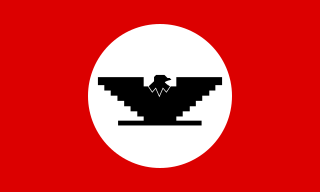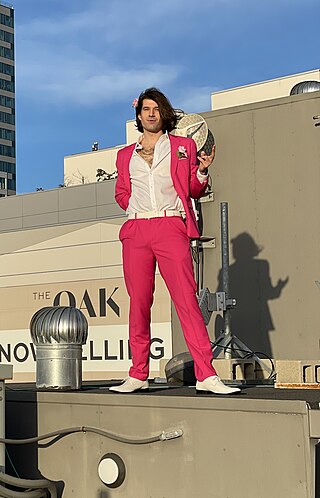Related Research Articles

Graffiti is writing or drawings made on a wall or other surface, usually without permission and within public view. Graffiti ranges from simple written "monikers" to elaborate wall paintings, and has existed since ancient times, with examples dating back to ancient Egypt, ancient Greece, and the Roman Empire.
The Mission District, commonly known as the Mission, is a neighborhood in San Francisco, California. One of the oldest neighborhoods in San Francisco, the Mission District's name is derived from Mission San Francisco de Asís, built in 1776 by the Spanish. The Mission is historically one of the most notable centers of the city's Chicano/Mexican-American community.

Barry McGee is an American artist. He is known for graffiti art, and a pioneer of the Mission School art movement. McGee is known by his monikers: Twist, Ray Fong, Bernon Vernon, and P.Kin.

Margaret Leisha Kilgallen was a San Francisco Bay Area artist who combined graffiti art, painting, and installation art. Though a contemporary artist, her work showed a strong influence from folk art. She was considered a central figure in the Bay Area Mission School art movement.

Street art is visual art created in public locations for public visibility. It has been associated with the terms "independent art", "post-graffiti", "neo-graffiti" and guerrilla art.

Precita Eyes Muralists Association is a community-based non-profit muralist and arts education group located in the Bernal Heights neighborhood of San Francisco, California. It was founded in 1977 by Susan and Luis Cervantes.
Piece by Piece is a 2005 American documentary film directed by Nic Hill. The film documents San Francisco's graffiti culture from the early 1980s to 2004. It is narrated by the San Francisco graffiti artist Senor One, better known as Renos.

OSGEMEOS are identical twin street artists Otavio Pandolfo and Gustavo Pandolfo. They started painting graffiti in 1987 and their work appears on streets and in galleries across the world.
Mural Arts Philadelphia is a non-profit organization that supports the creation of public murals in Philadelphia, Pennsylvania. Founded in 1986 as the Mural Arts Program, the organization was renamed in 2016. Having ushered more than 4,000 murals into being, it calls itself "the nation’s largest public art program." As of 2024, the organization runs 50 to 100 public art projects each year, including new murals in neighborhoods such as Kensington, Northern Liberties, and the Gayborhood. It also works to maintain existing murals.

The Mission School is an art movement of the 1990s and 2000s, centered in the Mission District, San Francisco, California.

Since the 1980s, the area surrounding the Sydney inner west suburb of Newtown, Australia, including the suburbs of Newtown, Enmore, Erskineville, Camperdown and St Peters, has been known for its wide range of prominent graffiti and street art on walls. The public visual art in the Newtown area consists of a variety of styles and methods of execution, including large-scale painted murals, hand-painted political slogans, hand-painted figurative designs, spray painted semi-abstract designs "tags"), and other stylistic developments such as stencil art and street poster art, "Yarn bombing", and sculptural items cast from plaster and other materials.
ESTRIA, also Todd Johnson, is a graffiti artist and muralist based in the San Francisco Bay Area.

Megan Wilson is an American visual artist, writer, and activist based in San Francisco. Known for her large-scale installations, public projects, and street art, she incorporates a broad range of pop culture methodologies and aesthetics to address conceptual interests that include home, homelessness, social and economic justice, anti-capitalism, impermanence and generosity. Wilson's art practice is influenced by Buddhism and Vipassanā meditation, often creating work that is conceptually rooted in elements of these practices and that is intentionally ephemeral or given away.

Graffiti in Toronto, Ontario, Canada, is a cause of much disagreement among its residents. Graffiti is seen by some as an art form adding to the Toronto culture; however, others see graffiti as form of vandalism, viewing it as ugly, or as a form of property damage.

Las Mujeres Muralistas were an all-female Latina artist collective based in the Mission District in San Francisco in the 1970s. They created a number of public murals throughout the San Francisco Bay Area, and are said to have sparked the beginning of the female muralist movement in the US and Mexico. Their murals were colorful and large scale and often focused on themes such as womanhood, culture, beauty, and socio-political change. Patricia Rodriguez, Graciela Carrillo, Consuelo Mendez, and Irene Perez are recognized as the founders and most prominent members of the collective, but other female Chicana artists assisted along the way and even joined later on, such as Susan Cervantes, Ester Hernandez, and Miriam Olivo among others.

Bip Apollo is a formerly anonymous painter and sculptor who is "known internationally for his role in spear-heading the North American street art revival" and creating in-demand luxury art. He initially came to public attention in 2010 around New Haven, Connecticut, moved to the San Francisco around 2013, and began extensively traveling internationally in 2015. Bip Apollo's studio is currently based between Monte Carlo, Monaco and San Francisco.
Jessica Sabogal is a queer Colombian-American muralist and stencil spray paint artist who is currently active in the Bay Area. She's best known for her "Women Are Perfect! " visual campaign which she created as an artist in residence in 2014 at the Galeria de la Raza, and she is currently active in the "We The People" public art campaign created in collaboration with Shepard Fairey.
Margo Consuela Bors is an American painter, muralist, photographer and illustrator active in the San Francisco Bay area. She is an activist for protecting native plants and animals is supported by big organizations like the California Native Plant Society.
Sirron Norris is an American illustrator, muralist, and arts educator. He is known for his work on the FOX animated television show Bob's Burgers and for numerous cartoon-style public murals, including ones at Balmy Alley, Clarion Alley, and Mission Dolores Park, and galleries around San Francisco. His murals often include political messages, local themes, and his signature blue bear. He has worked with several local non-profits, including SPUR and El Tecolote.
fnnch is a pseudonymous American street artist based in San Francisco. He often utilizes stencils and spray paint. His subjects frequently feature nature, such as birds, and pop art imagery, such as his honey bear series.
References
- 1 2 3 4 5 Piece by Piece. Dir. Nic Hill. Perf. Various Street Artists. Youtube. N.p., 11 Mar. 2012. Web. 23 Oct. 2016.
- 1 2 The Mural". womensbuilding.org. Retrieved 2016-11-14
- ↑ Rotman, Steve, and Chris Brennan. Bay Area Graffiti. New York: Mark Batty, 2008. Print.
- 1 2 Megler, Veronika, David Banis, and Heejun Chang. "Spatial Analysis of Graffiti in San Francisco." Applied Geography 54 (2014): 63-73. Web.
- 1 2 KQED Art School (2014-03-30), Bay Area Graffiti: The Early Years | KQED Arts, retrieved 2016-11-17
- ↑ "San Francisco Mural Arts | Mission". www.sfmuralarts.com. Retrieved 2016-11-26.
- 1 2 Hellmann, Melissa. "The Writing on the Wall: It's Graffiti Versus Murals in San Francisco and Oakland. Either Way, Street Artists Win." SF Weekly. Retrieved 2016-11-17.
- ↑ Douglas Mahoney . "The Pioneer : Graffiti: Street Art and Public Menace". thepioneeronline.com. Retrieved 2016-11-17.
- ↑ Ehrilic, Richard. "San Francisco's Graffiti War." CNN. Cable News Network, 3 Sept. 2014. Web. 02 Nov. 2016.
- 1 2 "California Code, Penal Code - PEN § 594".
- ↑ "San Francisco Cracks Down on Graffiti". NBC Bay Area. Retrieved 2016-11-16.
- ↑ "Prolific taggers finally have definitive brush with the law". San Francisco Chronicle. Retrieved 2016-11-16. I
- Brake, Brock. "Interview with Bay Area’s GATS Aka Graffiti Against the System." The Hundreds. N.p., 7 June 2015. Web. 02 Nov. 2016.
- Crawford, Cole. "The Bay Area’s Graffiti Wars - Hyphen." Hyphen. N.p., 16 Mar. 2016. Web. 02 Nov. 2016.
- Ehrilic, Richard. "San Francisco's Graffiti War." CNN. Cable News Network, 3 Sept. 2014. Web. 02 Nov. 2016.
- Metacalfe, John. "The Bay Area Graffiti Paradise Built on an Island of Garbage." CityLab. N.p., 02 Oct. 2014. Web. 02 Nov. 2016.
- Megler, Veronika, David Banis, and Heejun Chang. "Spatial Analysis of Graffiti in San Francisco." Applied Geography 54 (2014): 63-73. Web.
- Piece by Piece. Dir. Nic Hill. Perf. Various Street Artists. YouTube. N.p., 11 Mar. 2012. Web. 23 Oct. 2016.
- Rotman, Steve, and Chris Brennan. Bay Area Graffiti. New York: Mark Batty, 2008. Print.
- Smith, Christie. "Racist, Gang Related Graffiti Investigation at East Bay Park." NBC Bay Area. N.p., 27 Mar. 2016. Web. 02 Nov. 2016.
- Superstar, Jocelyn. Bay Area Graffiti: '80s-'90s: Early Bombing. Brooklyn, NY: Mark Batty, 2011. Print.